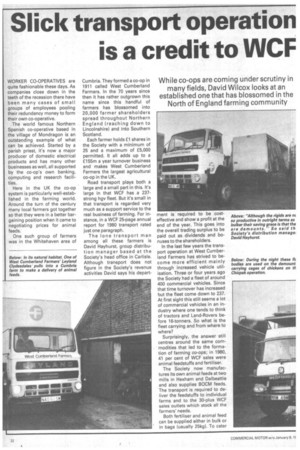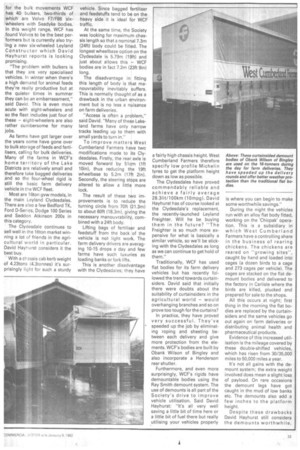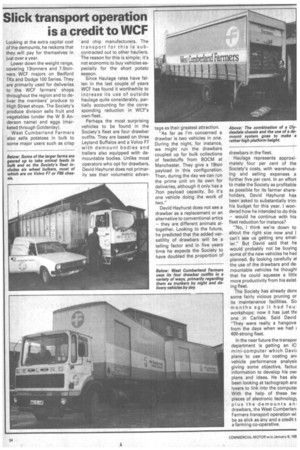Slick transport operation is a credit to WCF
Page 26

Page 27

Page 28

If you've noticed an error in this article please click here to report it so we can fix it.
While co-ops are coming under scrutiny in many fields, David Wilcox looks at an established one that has blossomed in the North of England farming community
WORKER CO-OPERATIVES are quite fashionable these days. As companies close down in the teeth of the recession there have been many cases of small groups of employees pooling their redundancy money to form their own co-operative.
The world famous Northern Spanish co-operative based in the village of Mondragon is an outstanding example of what can be achieved. Started by a parish priest, it's now a major producer of domestic electrical products and has many other businesses as well, all supported by the co-op's own banking, computing and research facilities.
Here in the UK the co-op system is particularly well-established in the farming world. Around the turn of the century many local farmers got together so that they were in a better bargaining position when it came to negotiating prices for animal feeds.
One such group of farmers was in the Whitehaven area of Cumbria. They formed a co-op in 1911 called West Cumberland Farmers. In the 70 years since then it has rather outgrown this name since this handful of farmers has blossomed into 20,000 farmer shareholders spread throughout Northern England (reaching down to Lincolnshire) and into Southern Scotland.
Each farmer holds E1 shares in the Society with a minimum of 25 and a maximum of £5,000 permitted. It all adds up to a £155m a year turnover business and makes West Cumberland Farmers the largest agricultural co-op in the UK.
Road transport plays both a large and a small part in this. It's large in that WCF has a 237strong hgv fleet. But it's small in that transport is regarded very much as a support service to the real business of farming. For instance, in a WCF 25-page annual report for 1980 transport rated just one paragraph.
The lone transport man among all these farmers is David Hayhurst, group distribution manager based at the Society's head office in Carlisle. Although transport does not figure in the Society's revenue activities David says his depart
ment is required to be costeffective and show a profit at the end of the year. This goes into the overall trading surplus to be paid out as dividends and bonuses to the shareholders.
In the last few years the transport operation at West Cumberland Farmers has strived to become more efficient mainly through increased vehicle utilisation. Three or four years ago the Society had a fleet of around 400 commercial vehicles. Since that time turnover has increased but the fleet come down to 237. At first sight this still seems a lot of commercial vehicles in an industry where one tends to think of tractors and Land-Rovers before 16-tonners. So what is the fleet carrying and from where to where?
Surprisingly, the answer still centres around the same commodities that led to the formation of farming co-ops; in 1980, 41 per cent of WCF sales were animal feedstuffs and fertiliser.
The Society now manufactures its own animal feeds at two mills in Hexham and Dalbeattie and also supplies BOCM feeds. The transport is required to deliver the feedstuffs to individual farms and to the 30-plus WCF sales outlets which stock all the farmers' needs.
Both fertiliser and animal feed can be supplied either in bulk or in bags (usually 25kg). To cater
for the bulk movements WCF has 40 bulkers, two-thirds of which are Volvo F7/F86 sixwheelers with Seadyke bodies. In this weight range. WCF has found Volvos to be the best performers but is currently also trying a new six-wheeled Leyland Constructor which David Hayhurst reports is looking promising.
"The problem with bulkers is that they are very specialised vehicles. In winter when there's a high demand for animal feeds they're really productive but at the quieter times in summer they can be an embarrassment," said David. This is even more acute with eight-wheelers and so the fleet includes just four of these — eight-wheelers are also rather cumbersome for many jobs.
As farms have got larger over the years some have gone over to bulk storage of feeds and fertilisers, calling for bulk deliveries. Many of the farms in WCF's home territory of the Lake Districts are relatively small and therefore take bagged deliveries and so the four-wheel rigid is still the basic farm delivery vehicle in the WCF fleet.
Most are 16ton gvw models, in the main Leyland Clydesdales. There are also a few Bedford TK, Ford D-Series, Dodge 100 Series and Seddon Atkinson 200s in this category.
The Clydesdale continues to sell well in the 16ton market winning a lot of friends in the agricultural world In particular. David Hayhurst considers it the best buy.
With a chassis cab kerb weight of 4.23tons (4.3tonnes) it's surprisingly light for such a sturdy vehicle. Since bagged fertiliser and feedstuffs tend to be on the heavy side it is ideal for WCF traffic.
At the same time, the Society was looking for maximum chassis length so that a nominal 7.3m (24ft) body could be fitted. The longest wheelbase option on the Clydesdale is 5.79m (19ft) and just about allows this — WCF bodies are in fact 7.2m (23ft 9in) long.
The disadvantage in fitting this length of body is that manouvrability inevitably suffers. This is normally thought of as a drawback in the urban environment but is no less a nuisance on farm deliveries.
"Access is often a problem," said David. "Many of these Lakeland farms have only narrow tracks leading up to them with small yards to turn in."
To improve matters West Cumberland Farmers have two modifications made to its Clydesdales. Firstly, the rear axle is moved forward by 51cm (1ft 10in), thus reducing the 19ft wheelbase to 5.2m (17ft 2in). Secondly, the steering stops are altered to allow a little more lock.
The result of these two improvements is to reduce the turning circle from 70ft (21.3m) to about 60ft (18.3m), giving the necessary manouvrability, combined with a 24ft body.
Lifting bags of fertiliser and feedstuff from the back of the vehicle is not light work. The farm delivery drivers are averaging 10-15 drops a day and few farms have such luxuries as loading banks or fork :ifts.
This is another disadvantage with the Clydesdales; they have a fairly high chassis height. West Cumberland Farmers therefore specify low profile Michelin tyres to get the platform height down as low as possible.
The Clydesdales have proved commendably reliable and achieve a fairly average 28.31it/100km (10mpg). David Hayhurst has of course looked at the Clydesdale's replacement, the recently-launched Leyland Freighter. Will he be buying them in the future? "The Freighter is so much more expensive for what is basically a similar vehicle, so we'll be sticking with the Clydesdales as long as we can continue to get hold of them."
Traditionally, WCF has used flat bodies for its farm delivery vehicles but has recently followed the trend towards curtainsiders. David said that initially there were doubts about the suitability of curtainsiders in the agricultural world — would overhanging branches and so on prove too tough for the curtains?
In practice, they have proved very successful. They've speeded up the job by eliminating roping and sheeting between each delivery and give more protection from the elements. WCF's bodies are built by Obank Wilson of Bingley and also incorporate a Henderson rear shutter.
Furthermore, and even more surprisingly, WCF's rigids have demountable bodies using the Ray Smith demount system. The use of demounts is all part of the Society's drive to improve vehicle utilisation. Said David, Hayhurst: "It's all very well saving a little bit of time here or a little bit of fuel there but really ,utilising your vehicles properly
is where you can begin to make some worthwhile savings."
During the night the vehicles run with an alloy flat body fitted, working on the 'Chicpak' operation. This is a subsidiary in which West Cumberland Farmers have a controlling share in the business of rearing chickens. The chickens are reared on "growing sites", caught by hand and loaded into cages (a dozen birds to a cage and 273 cages per vehicle). The cages are stacked on the flat demount bodies and delivered to the factory in Carlisle where the birds are killed, plucked and prepared for sale to the shops.
All this occurs at night; first thing in the morning the flat bodies are replaced by the curtainsiders and the same vehicles go out again on farm deliveries or distributing animal health and pharmaceutical products.
Evidence of this increased utilisation is the mileage covered by these double-shifted vehicles, which has risen from 30/35,000 miles to 50,000 miles a year.
It's not all gains with the demount system; the extra weight involved does mean a slight loss of payload. On rare occasions the demount legs have got caught in the mud of low banks etc. The demounts also add a few inches to the platform height.
Despite these drawbacks David Hayhurst still considers the demounts worthwhile. Looking at the extra capital cost of the demounts, he reckons that they will pay for themselves in just over a year.
Lower down the weight range, covering 13tonners and 7.5tonners WCF majors on Bedford TKs and Dodge 100 Series. They are primarily used for deliveries to the WCF farmers' shops throughout the region and to deliver the members' produce to High Street shops. The Society's produce division sells fruit and vegetables (under the W B Anderson name) and eggs (marketed through Goldenlay).
West Cumberland Farmers also sells potatoes in bulk to some major users such as crisp and chip manufacturers. The transport for this is subcontracted out to other hauliers. The reason for this is simple; it's not economic to buy vehicles especially for the short potato season.
Since Haulage rates have fallen in the last couple of years WCF has found it worthwhile to increase its use of outside haulage quite considerably, partially accounting for the corresponding reduction in WCF's own fleet.
Perhaps the most surprising vehicles to be found in the Society's fleet are four drawbar outfits. They are based on three Leyland Buffalos and a Volvo F7 with demount bodies and trailers also equipped with demountable bodies. Unlike most operators who opt for drawbars, David Hayhurst does not primarily see their volumetric advan tage as their greatest attraction.
"As far as I'm concerned a drawbar is two vehicles in one. During the night, for instance, we might run the drawbars coupled up for bulk collections of feedstuffs from BOCM at Manchester. They give a 19ton payload in this configuration. Then, during the day we can run the prime unit on its own for deliveries, although it only has a 7ton payload capacity. So it's one vehicle doing the work of two."
David Hayhurst does not see a drawbar as a replacement or an alternative to conventional artics — they are different animals altogether. Looking to the future, he predicted that the added versatility of drawbars will be a telling factor and in five years time he expects the Society to have doubled the proportion of drawbars in the fleet.
Haulage represents approximately four per cent of the Society's costs, with warehousing and selling expenses a further five per cent. In an effort to make the Society as profitable as possible for its farmer shareholders, David Hayhurst has been asked to substantially trim his budget for this year. I wondered how he intended to do this — would he continue with his fleet reduction for instance?
"No, I think we're down to about the right size now and I can't gee us getting any smaller." But David said that he would probably not be buying some of the new vehicles he had planned. By looking carefully al the use of the drawbars and demountable vehicles he though1 that he could squeeze a little more productivity from his exist. ing fleet.
The Society has already done some fairly vicious pruning or its maintenance facilities. Si) months ago it had fou workshops; now it has just the one in Carlisle. Said David "They were really a hangove from the days when we had e 400-strong fleet.
In the near future the transpor department is getting an ICI mini-computer which Davh plans to use for costing ant vehicle performance analysis giving some objective, factua information to develop his owl plans and ideas. He has alsi been looking at tachograph ana lysers to link into the compute' With the help of these tw, pieces of electronic technologN plus the demounts an drawbars, the West Cumberlani Farmers transport operation wi be as slick as any and a credit t a farming co-operative.










































